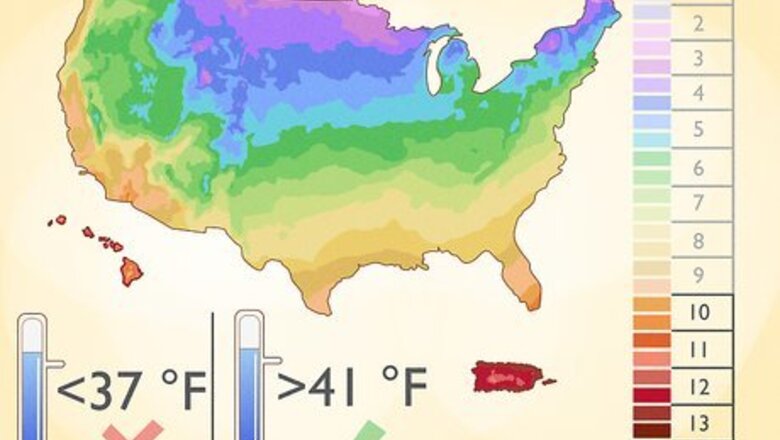
views
Choosing a Growing Area
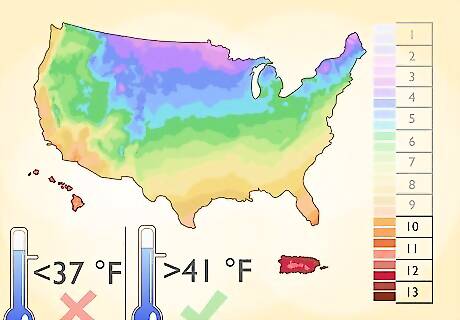
Grow guanabana in a warm, humid environment. As a tropical plant, guanabana can’t survive in cold areas. In the U.S., for example, it can only be raised in USDA areas 10 through 13. Look up a map of growing areas to see how your planting area compares to these zones. The USDA zone map divides areas according to their climate, which can help you determine what plants grow well in your area. Guanabana trees grow best in warm temperatures but do best in temperatures consistently above 41 °F (5 °C). They won’t survive in temperatures below 37 °F (3 °C). If you live in a cooler climate, you can still grow guanabana in a greenhouse.

Pick an area that experiences at least 6 hours of sunlight a day. Areas that experience full sunlight are the ideal growing spot for guanabana trees. The sun keeps the soil dry and your guanabana warm. However, guanabanas may also survive in areas that experience partial shade. Partial shade indicates a spot that receives 4 to 6 hours of sunlight a day. The trees aren’t likely to survive in areas that get less sunlight than that.
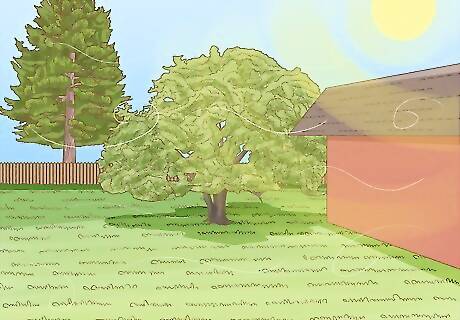
Grow the tree in a spot that offers wind protection. Having trees, walls, and other structures around the guanabana helps it survive. Guanabana trees have short roots, so a strong wind can potentially knock them over. Planting the trees behind a wind buffer also ensures you don’t wake up to a tree without any leaves left to insulate it. Walls are a good option because they absorb and radiate heat needed to keep the tree warm. You can also plant guanabana behind a building. Monitor which direction the wind blows towards, then plant the tree on the opposite side. Another way to protect a tree is to plant stakes in the ground. Stretch burlap or plastic between the stakes to block the wind.

Space the tree apart from other trees and structures. The tree still needs adequate space to grow. Keep in mind that guanabana can grow 30 ft (9.1 m) tall and 10 ft (3.0 m) wide. Give it plenty of space and make sure it can’t fall on anything valuable. Plant the tree at least 7 ft (2.1 m) from other trees. Keep it at least 20 ft (6.1 m) from buildings and walls.

Choose a spot with well-draining, sandy soil. Guanabana trees have shallow roots that don’t require much water. They require soil that drains quickly, which makes sandy soil the best option. You can mix organic amendments into your soil to get it to drain faster. Guanabana trees can tolerate a wide range of soils. For example, mix compost, builder’s sand, vermiculite, or peat about 8 in (20 cm) into the soil. You can watch your growing area after a hard rain to see how it drains. Avoid areas that still have pools of water a few hours after the rain stops.

Adjust the soil pH to 5 to 6.5. You can get a soil testing kit at a home improvement store. Guanabana trees grow in slightly acidic soil. If your soil isn’t at the right pH, mix chemicals into it to change the pH. It’s easier to grow a plant suitable for your soil type rather than altering the soil pH. Mixing in sulfur or aluminum sulfate can make the soil more acidic. Adding organic material such as compost makes the soil more acidic, so be aware if you use it for drainage purposes.
Germinating Seeds
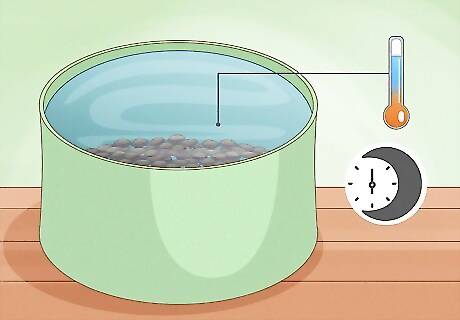
Soak guanabana seeds in warm water overnight. Most guanabana trees are grown from seeds, which you can order online or get from a guanabana’s fruit. Fill a cup with warm water. Place the seeds in the cup to ready them for planting the next day. If you are planting a sapling, you can immediately plant the tree in soil outside or in a greenhouse.
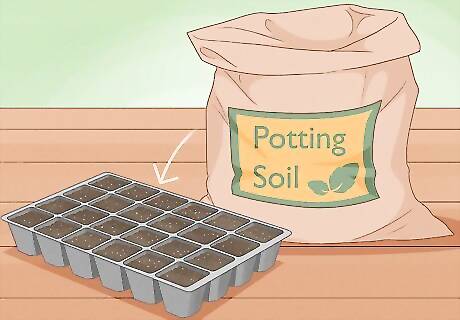
Fill a pot with a seed-starting mix. You will need a growing tray, which you can purchase at a gardening center. Also, find a bag of mix, and then distribute it evenly in the tray. Pour the mix in until it is up to the tray’s rim. You can make your own mix by combining 1 part perlite, 1 part vermiculite, and 1 part coco peat or peat moss. Avoid using soil from your yard, since this soil is not sterilized and can harm the seed.

Plant the seeds in the tray. Distribute the guanabana seeds evenly throughout the tray. Push them about ⁄2 in (1.3 cm) deep into the mix. If you plant multiple seeds, expect most of them to sprout. You can plant them, give them away, or get rid of them.

Leave the tray in a shady spot until the guanabana sprouts. Shade prevents the seed mix from drying out. Although guanabana trees do well in sunlight, it is better to make sure the seeds begin growing before putting them in it. Keeping the soil moist is more important when starting the seeds. After the seeds sprout in 2 to 4 weeks, you can move the tray to partial sunlight to prepare them for transplanting. Partial sunlight is 4 to 6 hours of sunlight a day. Keep the tray out of full sunlight until the seeds are ready to be transplanted.

Water the mix daily for 2 to 4 weeks. Water the mix immediately after planting the seeds. Then, return each day to make sure the mix is moist. You can do this by using a spray bottle to give the soil a light misting.
Transplanting Seeds

Transplant the seedling once it outgrows the tray. After at least a month, the seedling may get too big for the growing tray. You can transplant it immediately into a pot or a black plastic bag. Make sure the container is bigger than the plant and filled with potting mix. The container also should have holes on the bottom for water drainage. If you use a black plastic bag, you can poke drainage holes in the bottom.

Dig the seed out of the growing tray. Moisten the soil as needed to loosen it. Carefully dig around any seeds you have in the tray so you don’t disturb the roots. You can shift the soil by hand. Uncover the roots, then support the roots with 1 hand as you lift the plant safely out of the tray. Damaging the roots can be bad news for your guanabana tree, so work slowly.

Move the tree to the pot after 1 month. In the planting pot, dig out a hole the size of the root ball. Move the tree into the hole, then cover the roots and continue to moisten the soil every day. You can keep your guanabana in a pot indefinitely. This is helpful if you live in climates where you need to move the tree inside to protect it. Keep in mind that it will eventually get very tall.

Transplant the tree outdoors after 6 months. If you can wait the full 6 months, you should have a strong sapling that can survive outdoors. Carefully shift the potting mix away from the seed to uncover its roots. If the soil is hard to move, use a spade or trowel to work around the edges of the pot.

Plant the tree in the ground outside. Dig a hole the size of the root ball. Center your tree in the hole, then spread dirt over the roots. Cover the roots completely, making sure the soil level meets the point where the roots attach to the tree’s trunk. Barring bad weather, your tree should be good to grow. You can usually reduce watering to about once a week at this point.

Spread an organic mulch around the plant. Applying about 3 in (7.6 cm) of mulch is recommended. Get an organic mulch, such as pine bark, from a gardening center. Rake the mulch evenly across the planting area, making sure the mulch doesn’t touch the tree’s trunk. Mulch holds moisture in the soil, which prevents the tree’s shallow roots from drying out.
Maintaining Guanabara Trees

Water the tree when the soil dries during a drought. If your area experiences a period of drought, water the soil lightly to help the tree survive. Add enough water to moisten the soil about 3 in (7.6 cm) deep. You can test the soil by pushing your finger into it. If you can’t push down to the roots easily, the soil needs water. An irrigation system works well for greenhouse growing.

Fertilize the tree in spring and fall. Give the guanabana plenty of fertilizer every year to help it grow and produce fruit. You can add fertilizer a month after planting or around March. Apply a second dose in early September. You can use a balanced 10-10-10 fertilizer from your gardening center, which has equal parts phosphorus, nitrogen, and potassium. Apply ⁄4 lb (0.11 kg) of fertilizer in the first year, ⁄2 lb (0.23 kg) in the second year, and 1 ⁄2 lb (0.68 kg) every year after that.

Renew the layer of mulch every year. Check the mulch layer before you add new fertilizer. Add a new layer of an organic material, such as compost or pine bark, in early spring. Then, you can finish tending to the tree by putting the fertilizer on top of the mulch. Replace the mulch every year to block out weeds and keep the surrounding soil moist.

Prune the tree down in the first year. Wait for the guanabana’s trunk to become at least ⁄2 in (1.3 cm) thick. Using pruning shears, cut the branches down until the tree is about 30 in (76 cm) tall. Then, wait for new shoots to grow. Regular pruning helps your tree grow evenly so more water and sunlight reach the roots. New shoots will grow on your tree. Select the tallest shoot to be the central leader, then select 3 or 4 shoots spaced around it to be main branches. Wear a thick pair of gardening gloves and safety goggles to protect your eyes.

Reduce the tree’s size in the second year to encourage growth. Trim the central leader to about ⅓ of its original size. New shoots will begin forming around the cut. Choose the tallest shoot again, then pin the other shoots down so they are horizontal. You can pin down the secondary shoots with clothespins or twine. Also remove any diseased or decaying branches on your tree.

Use an insecticide to treat infestations. Although guanabana trees do not attract a lot of pests, some bugs can be an issue. Mealybugs are common, along with lace-wing bugs, moths, and fruit flies. Look for holes in the leaves, bark, or fruit. Spray a pesticide directly onto the plant. Consider using natural methods of pest treatment, like insecticidal soap or horticultural oil. Wear a respirator and eye protection when spraying chemicals. Keep people and pets out of the area. Root rot is a disease some guanabanas experience. This is usually caused by too much water.

















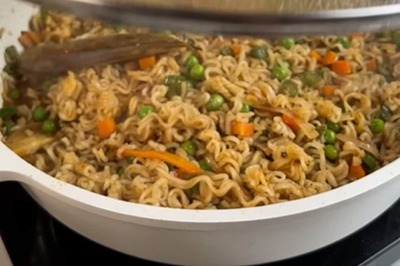


Comments
0 comment